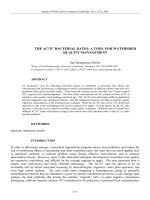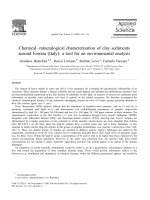Math Reality vs. Math Myth: A Partnership for Student Success
Bạn đang xem bản rút gọn của tài liệu. Xem và tải ngay bản đầy đủ của tài liệu tại đây (226.32 KB, 36 trang )
Math Reality vs. Math Myth:
A Partnership for Student Success
Dianne Siegfreid, Concurrent Enrollment, Weber State University, Utah
Dixilee Blackinton, Developmental Math, Weber State University, Utah
Lisa Jasumback, K-12 Math Supervisor, Davis School District, Utah
The Salt Lake Tribune
August 18, 2004
Utah up on ACT scores
Overall results make educators
happy, but math still a struggle
Fewer then half of collegebound grads from 2004 will
do well in college math
courses.
“…math remains the toughest of
the ACT exams, reinforcing
revelations from another
measure: the Utah Basic Skills
Competency Test…”
Weber State University
Demographics
• Primarily an undergraduate 4-year
institution
• Open Enrollment
• Approximately 18,000 students
• Commuter Campus
Weber State University
Demographics continued
• 39% Non-traditional Students
• 60% Students are full time
• 89% of students work at least 10
hrs. per week
• 38% are married
The University Viewpoint
• Student body has changed
• Student preparation has not kept
pace
• Most high school intermediate
algebra students land in college
developmental math
The University Viewpoint continued
• Low passing rates in
developmental math
• Trust issue between college and
high school
• Higher math placement enhances
college success
Math Placement
•
Only 30% are eligible for college level math
•
Less than ACT 23 score and COMPASS
Placement
905 (Prealgebra)
50%
960 (Beg. Algebra) 25%
1010 (Int. Algebra) 7%
Higher Courses
16%
Prognosis of Earning a Degree
• 10-year Analysis (1990-2000)
First Course
Prealgebra
Beg. Algebra
Passed MC/QL
1.8%
3.8%
Degree
11.4%
22%
• 1-year Analysis (Admitted Summer 1998-Spring 1999)
First Course
Achieved QL
Prealgebra
9%
Beg. Algebra16%
Int. Algebra
34%
Still Enrolled
34%
36%
44%
Davis School District
Demographics
• K-12 Public School System
• Suburban, just north of Salt Lake City
• Includes 9 Title 1 Elementary Schools
• 60,000 students currently, expected to
increase 20,000 in the next ten years
7th Graders Enrolled in
Algebra
19992000
20002001
20012002
20022003
16%
16%
17%
15%
Math Course Taking Patterns of Seniors
(2004) Who Were Enrolled in Algebra As
7th Graders
100
90
80
70
60
50
40
30
20
10
0
ALG-7
GEO-8
ALG2-9 PREC-10
AP-11
AP+-12
Distribution of Grades
70
60
A
B
C
D
F
N
50
40
30
20
10
0
7th
8th
9th
10th
11th
Using the 6th Grade CRT To
Identify
Students For Algebra
6th grade
CRT
99
97
96
96
96
93
93
93
91
91
91
91
91
90
90
90
89
7TH
7TH
7TH
7TH
7TH
7TH
7TH
7TH
Pre-Alg Pre-Alg Pre-Alg Pre-Alg Algebra Algebra Algebra Algebra
1st term 2nd term 3rd term 4th term 1st term 2nd term 3rd term 4th term
AA
AAAAB+
A
B+
C
DF
A
A
A
A
A
AA
A
B+
B
AAA
AA
A
A
A
A
A
B+
B
B
AF
D
F
DA
A
A
B
AB
A
B
A
AA
B+
A
A
AB+
B+
B
ABA
A
A
A
A
A
A
A
Eighth Grade
8TH
8TH
8TH
Algebra Algebra Algebra
1st term 2nd term 3rd term
AB
A-
A-
A-
B+
BA
C+
A
BC+
B+
D
B-
8TH
Algebra
4th term
8TH
8TH
8TH
8TH
Geometry Geometry Geometry Geometry
1st term 2nd term 3rd term 4th term
A
AA
AA
A
A
A
F
A
A
A
A
B+
A
B+
B+
A
C+
AA
B
B+
A
B-
C
AA
B
B+
A
BA
A
C+
AA
A
A
A
A
AA
A
A
A
A
A
A
A
A
B
A
Ninth Grade
9TH
9TH
9TH
9TH
Algebra Algebra Algebra Algebra
1st term 2nd term 3rd term 4th term
B
C
C
9TH
9TH
9TH
9TH
9TH
9TH
9TH
9TH
Geometry Geometry Geometry Geometry Int. Alg. Int. Alg. Int. Alg. Int. Alg.
1st term 2nd term 3rd term 4th term 1st term 2nd term 3rd term 4th term
AB+
A
AA
AAA
B+
B+
B+
CA
A
A
AC+
D+
C+
C+
AAAAC+
C+
BD+
AA
A
ABBC
C
A
A-
A
A-
C
AB
DAC+
A
B+
C
D+
B+
D-
BAB+
C+
B
A-
BB+
A-
D
B
A-
A
Tenth Grade
10TH
10TH
10TH
10TH
Geometry Geometry Geometry Geometry
1st term 2nd term 3rd term 4th term
10TH
10TH
10TH
10TH
Int. Alg. Int. Alg. Int. Alg. Int. Alg.
1st term 2nd term 3rd term 4th term
Mtn. High
B+
A
D+
D-
D-
A
B-
AA
BC+
A
CA
A
A
A
B+
A
C
B
A
C
BA
C+
C
A
D
A
B
A
A-
B+
AB+
ABA
A
B+
A-
A
B+
A
CA
F
A-
A
C+
10TH
10TH
10TH
10TH
Precalc Precalc Precalc Precalc
1st term 2nd term 3rd term 4th term
A
A
AAA
A
A
A
B
B-
C
D
A
A-
A-
B
Eleventh Grade
11TH
11TH
11TH
Int. Alg. Int. Alg. Int. Alg.
1st term 2nd term 3rd term
11TH
11TH
11TH
Precalc Precalc Precalc
1st term 2nd term 3rd term
11TH
11TH
Calc AB Calc AB
1st term 2nd term
C+
C+
B
B-
11TH
Calc AB
3rd term
BB+
B+
A
A-
B
B+
F
A
F
A-
A-
D
B
A-
BB
BB
D+
A-
A
D
B+
B+
B+
B
D
B
A
Differences Between High
School/College Math
High School
College
Student Body
All Students
Top 70%
Pedagogy
Procedural-How
Analytical-Why
Curriculum
Int. Algebra in College
Int. Algebra H.S.
Required Out of Class Study Time
Minimal
2 Hours per Hour In
Differences Between High
School/College Math
continued
High School
College
Assessment
Algorithms
Application of
Concept
Grading
Some NonAchievement
Indicators
Demonstrated
Achievement
Typical Barrier to
Concurrent
Math
• Lack of Trust
• Trust: collaborate on professional
development for teachers to enhance
student math readiness
Typical Barrier to
Concurrent
Math
• Need for High Standards
• Standards: require content,
exams, assignments and grading
scale to match college
Typical Barrier to
Concurrent
Additional Effort by College Faculty
Math
Additional Effort: train teachers to
use collegiate grading scale and
require a grading portfolio review
Solutions
continued
• Limited contact with students
• Limited contact: sponsor visits by
collegiate faculty to concurrent
classes to meet and work with
students
WSU-DSD Collegiate
Math Success
Pilot Program









